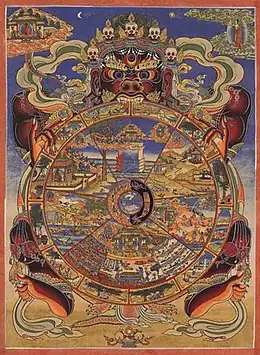
| Six Paths | |||||||||||
|---|---|---|---|---|---|---|---|---|---|---|---|
| Chinese name | |||||||||||
| Chinese | 六道 | ||||||||||
| |||||||||||
| Alternative Chinese name | |||||||||||
| Chinese | 六趣 | ||||||||||
| |||||||||||
| Vietnamese name | |||||||||||
| Vietnamese alphabet | Sáu cõi luân hồi Sáu đường Lục đạo | ||||||||||
| Hán-Nôm | 𦒹𡎝輪迴 𦒹塘 六道 | ||||||||||
| Korean name | |||||||||||
| Hangul | 육도 | ||||||||||
| Hanja | 六道 | ||||||||||
| |||||||||||
| Japanese name | |||||||||||
| Kanji | 六道 | ||||||||||
| Kana | ろくどう | ||||||||||
| |||||||||||
| Filipino name | |||||||||||
| Tagalog | Sadgati (ᜐᜀᜄᜀᜆᜒ) | ||||||||||
| Sanskrit name | |||||||||||
| Sanskrit | षड्गति (ṣaḍgati) | ||||||||||
The Six Paths[1] in Buddhist cosmology[2] are the six worlds where sentient beings are reincarnated based on their karma, which is linked to their actions in previous lives. These paths are depicted in the Bhavacakra ("wheel of existence").[3] The six paths are:[4]
- the world of gods or celestial beings (deva) ;
- the world of warlike demigods (asura) ;
- the world of human beings (manushya) ;
- the world of animals (tiryagyoni) ;
- the world of hungry ghosts (preta) ;
- the world of Hell (naraka).
The first three paths are known as "the three benevolent destinies" (kuśalagati), where beings experience varying degrees of virtue, pleasure, and pain. The last three paths are referred to as the three unbenevolent destinies (akuśalagati), where beings lack virtue and suffer predominantly. Typically, we as human beings only perceive the animals around us. The first Buddhist texts mention only five paths without distinguishing between the paths of devas and asuras.[4] In Japan, the monk Genshin even inexplicably places the path of humans below that of the asuras.[5]
The elements forming karma are constituted in bodily, oral or mental volitional acts. The chain of transmigration due to the Three Poisons (hatred, greed, ignorance), of which ignorance (avidyā) of the ultimate truth (Sanskrit: paramārtha; Chinese: zhēndì 真谛) or the true law (Sanskrit: saddharma, सद्धर्म, correct law; Chinese: miàofǎ, 妙法, marvelous law) is generally presented as the source of reincarnation in the three non-benevolent destinies.[6]
See also
References
- ↑ Quentin Ludwig, Le grand livre du bouddhisme, p. 179
- ↑ Robert E. Buswell Jr; Donald S. Lopez Jr (2013). The Princeton Dictionary of Buddhism. Princeton (N.J.): Princeton University Press. pp. 111–112. ISBN 978-0-691-15786-3..
- ↑ Damien Keown; Charles S. Prebish (16 December 2013). Encyclopedia of Buddhism. Taylor & Francis. p. 340. ISBN 978-1-136-98595-9.
- 1 2 Buswell, Robert E. (2004). Encyclopedia of Buddhism. Vol. 2. Macmillan, Thomson, Gale. pp. 711–712. ISBN 978-0-02-865718-9.
- ↑ Erika Peschard-Erlih (1993). "La mort des dieux". Ebisu (in French). Maison franco-japonaise (1): 71. ISBN 9782738420473.
- ↑ Buswell, Robert E. (2004). Encyclopedia of Buddhism. Vol. 1. Macmillan, Thomson, Gale. pp. 185–186. ISBN 978-0-02-865719-6.